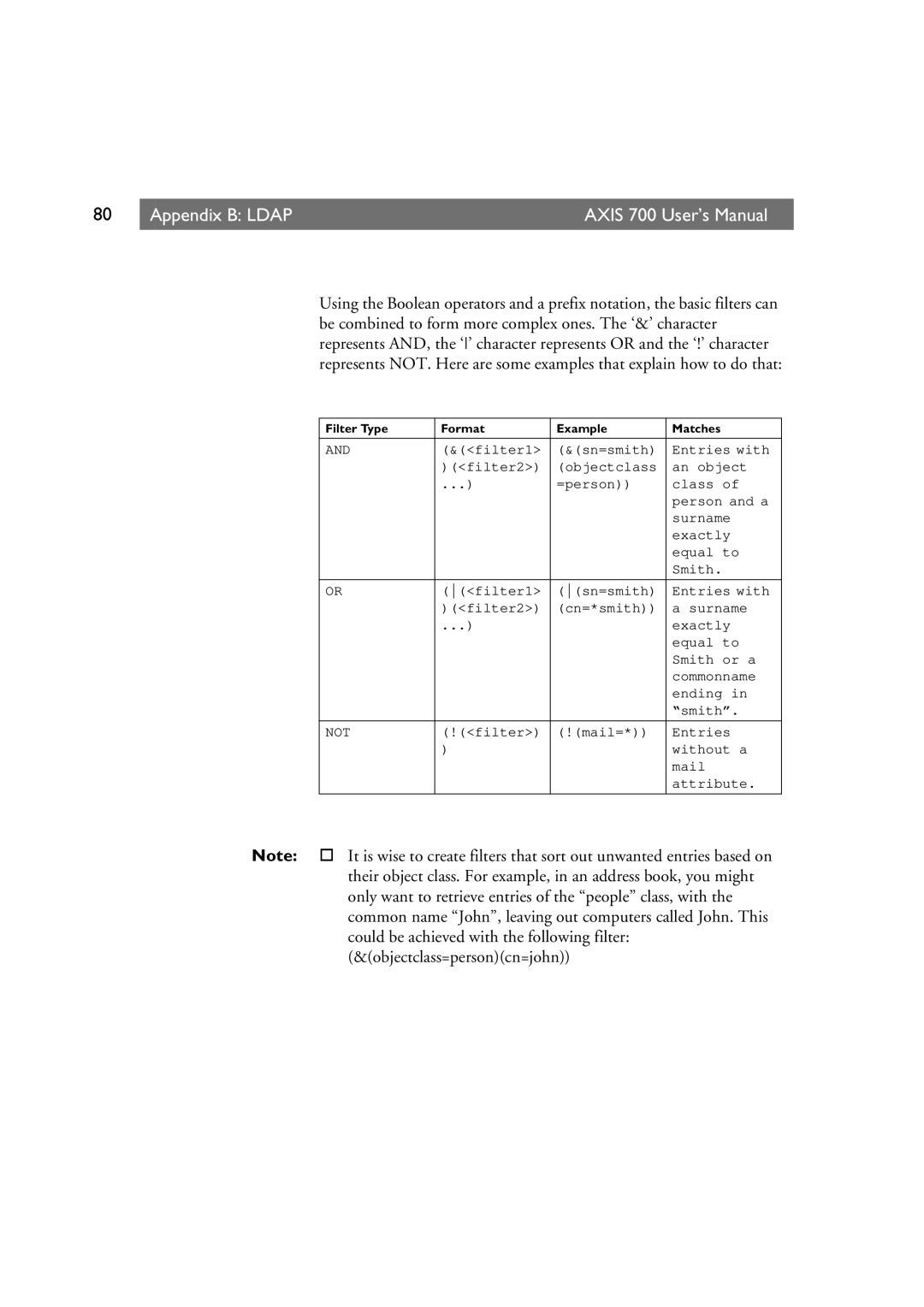E rs M a n u a l v 1
OlXg D77 User’s Manual
User’s Manual
Copyright Axis Communications AB, 1997
Axis 700 User’s Manual Revision
OlXg D77 User’s Manual Preface
Dwy
OlXg D77 User’s Manual Table of Contents
Huv
Zny SII t y
OlXg D77 User’s Manual Introduction
Xxy
GywXx
Xyyy
Kyv gy
Axis 700 over the network using FTP
Than the other way around
Auy
GywXx
Guxux xyy
OlXg D77 User’s Manual Basic Installation
GywPuXu
Duy
Puw duy
$,6 9HUVLRQ
Ay The Menu key scrolls the menu Enter key
Cancel key
Up and Down keys scroll and select menu options
Ruwy
Always consult the Network Administrator before making
Scanning device documentation on how to do this
Changes to the network configuration
Turn off the Axis 700 by unplugging the power supply
Where x.xx is the software version number
Power up the Axis 700. Press Menu
After a few seconds this display will be shown
Press Enter to edit the default router address
Press Enter to edit the IP address
Press Enter to edit the subnet mask
Jyy
Press Menu once more to display the final instructions
Byy
From the Axis 700 control panel
Sux
Cyyz
Xd Oxx
SWRd
Au bu
IWRd
Host will return ‘Reply from 172.19.2.254...’ or a similar
Communication is established
Your Axis 700. Type arp -a to display the ARP table
IbXl u cg69
IP address and verify the communication
Ether for Ethernet networks, e.g. arp -s ether spserv
Ethernet address Host name
Icchd
Typically performed using the command bootpd -a
Where
Required by your system
Http//172.19.2.254
GywPuXu
Network protocol settings
OlXg D77 User’s Manual Configuring the Axis
This brings you to the Axis 700 Home
GywRlXg D77
OlXg D77 User’s Manual Configuring the Axis
Click Network Settings
Tyu
Auhd0
Oxxy
Sy jy
GywRlXg D77
OlXg D77 User’s Manual Configuring the Axis
From this page you can set the following parameters
T4hd0
Tu Oxxy
=countrycode
Last five fields only apply to file destinations.
Configuration parameters are described in The Parameter
Description, Transfer method and Destination fields are
Mandatory for all destination types. For FTP destinations,
Destination Name is the text that will appear
Table. Click Detailed to view the detailed settings
Destination list on the Axis 700 control panel
Can make these temporary destinations permanent by clicking
Mail addresses using the Smtp protocol
T4uy
Mail destinations
GywRlXg D77
When the URL is sent to an e-mail destination
If z Tu
Will be stored
Click Destination Defaults to change the default values
Syyzu
Information
Filenamesequencenumber.fileextension, e.g. image001.tif
GywRlXg D77
Iy c
Profile Name list to edit an existing profile
Most needs. This table lists the predefined profiles
Axis 700 interface
Click New Profile to add a new profile to the list
OlXg D77 User’s Manual Configuring the Axis
GywRlXg D77
OlXg D77 User’s Manual Configuring the Axis
GywRlXg D77
OlXg D77 User’s Manual Using the Axis
T4u
Gywi Xg D77
Gwu if
Kyv P
Optionally, press Menu To change the default settings for
Axis 700 display shows Send to xxxxxx when it is
Destinations on
Perform these instructions from the Axis 700 control panel
Several separate pages or stacks of papers
Setting
Canon DR-3020 scanner. a job separation sheet inserted in a
Yv gyu gyy
Other separation pages will be ignored
Sharp AR-series
Line
Down or re-started
Administrator might not allow users to add temporary
Interface
Enter the name or IP address of your Axis 700 on
OlXg D77 User’s Manual Using the Axis
Default profile is Text
This table outlines when to use the predefined profiles
Depending on your scanning device, some profiles may not be
Black/white scanning devices, unless they can do gray-scale
Default paper size is Letter
Maintained by the Administrator
Du g
Syx
Example
Several separate pages
Xux
CRf uw
Owuyuxy
OlXg D77 User’s Manual Using the Axis
Owy
FTP
Axis 700 User’s Manual Appendix a Troubleshooting
OG h Axis 700 User’s Manual
Tml
Gu Xxu By Xxwu czz
This table lists a summary of error conditions
CDB
Flatbed only
Work. Attached scanner id is displayed in the event log
Axis 700 Home Page is displayed. Click Administration
Field and press Enter
Event log is displayed
Accessed with location-independence
Ldap allows resources and services to be selected with ease
Axis 700 User’s Manual Appendix B Ldap
System looks like
Axis 700 User’s Manual
Dwwu
Only want to retrieve entries of the people class, with
Could be achieved with the following filter
Objectclass=personcn=john
Axis 700 User’s Manual Appendix B Ldap
Axis 700 User’s Manual
OlXg D77 User’s Manual Appendix C The Parameter List
Gives a brief description of the parameter
As in the table below
ORG h
DefaultRouter
URL
Smtp
= Destination name
END
Where you can download the latest versions of the software
Compare against the latest software issues from Axis
Axis web site on how to join the AxisNews
OlXg D77 User’s Manual Appendix D Updating the Software
OSG i y
OlXg D77 User’s Manual Appendix D Updating the Software
OSG i y
File Transfer Protocol FTP server
Client Web browser, and at least one of these protocols
Simple Mail Transfer Protocol Smtp server
Netscape Navigator 3.0 or higher
Ouu
Software over the network using FTP
Number is limited by the Eeprom memory. If using Ldap or
12V DC 36VA, via external power unit Axis PS-C or
12V DC 13,2VA, via external power unit Axis PS-E
Ouu
OlXg D77 User’s Manual Appendix F Glossary
Axis 700 User’s Manual
OlXg D77 User’s Manual Appendix F Glossary
100
OlXg D77 User’s Manual Index 101
Http
Dhcp Rarp
OlXg D77 User’s Manual Index 103
